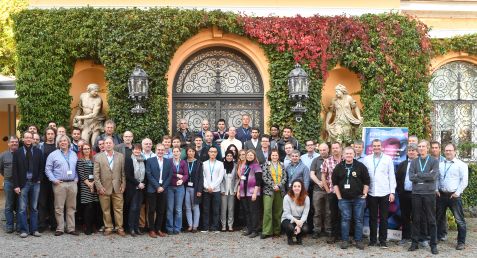MLZ is a cooperation between:
 > Technische Universität München
> Technische Universität München > Helmholtz-Zentrum Hereon
> Helmholtz-Zentrum Hereon
 > Forschungszentrum Jülich
> Forschungszentrum Jülich
MLZ is a member of:
 > LENS
> LENS > ERF-AISBL
> ERF-AISBL
MLZ on social media:

MLZ (eng)
Lichtenbergstr.1
85748 Garching
14.10.2017
Reger Austausch beim JCNS-Workshop 2017
14.10.2017
Lively Discussions at the JCNS Workshop 2017

Neutron Scattering Group photo of the JCNS Workshop 2017: Trends and Perspectives in Neutron Scattering in Tutzing. © Forschungszentrum Jülich
This year, the annual JCNS Workshop addressed the issue of “Trends and Perspectives in Neutron Scattering: Probing Structure and Dynamics at Interfaces and Surfaces”. Held at the Evangelische Akademie in Tutzing on Lake Starnberg, south of Munich, from 10-13 October, more than 70 participants were in attendance to discuss recent developments and scientific challenges in interface structure and dynamics in soft matter, magnetism and condensed matter systems.
Keynote lectures were given by Tommy Nylander (Lund), Maikel Rheinstaedter (McMaster), Ali Zarbaksh (Queen Mary), Adrian Rennie (Uppsalla), Regine von Klitzing (Darmstadt), Stefan Wellert (TU Berlin) and Peter Müller-Buschbaum (TU München) in the field of surfaces and interfaces in soft matter systems. Björgvin Hjörvarson (Uppsalla), Mike Fitzsimmons (ORNL), Andreas Michels (Luxembourg), Sean Langridge (ISIS) and Valeria Lauter (ORNL) introduced the challenges and requirements involved in magnetic and solid phase systems. Robert Cubitt (ILL) described recent achievements in novel instrumentation for reflectometry, while Andrew Jackson (ESS), Artur Glavic (PSI), Peter Falus (ILL), Brian Maranville (NIST), Olaf Holderer (JCNS) and Henrich Frielinghaus (JCNS) presented both the latest and future options in grazing incidence scattering, reflectometry and neutron spin echo grazing incidence spectroscopy.
The invited and contributed presentations led to lively discussions about the phenomena and requirements of studying structure and dynamics at surfaces and interfaces. Thin films as well as nanostructures at and below interfaces were discussed. Andrew Jackson and Artur Glavic gave a perspective on how to investigate surfaces even below 1 mm2 using appropriate optics. Bob Cubitt and Stefan Mattauch (JCNS) presented time-resolved measurements on the millisecond scale. Wolfgang Kreuzpaintner (TUM) demonstrated in-situ measurements within MBE systems, while Amir Syed Mohd (JCNS) gave an example of an advanced MBE sample environment at JCNS to combine ex-situ and in-situ surface measurements.
Besides the oral presentations, extensive discussions took place during the ongoing poster sessions, coffee breaks and dinner, and continued in the relaxed atmosphere of the lounge area of the Akademie in the evening. This lent the workshop an especially cordial ambience, the highlight of which was an excursion to the nearby radome at Raisting, Germany’s first commercial earth station for satellite communication. An enjoyable dinner rounded off the workshop where Thomas Brückel, Director of JCNS, expressed his thanks to all participants and hoped to welcome them again at the next JCNS Workshop in 2018.
Text: Thomas Gutberlet
More information on the website of the JCNS-Workshops 2017 “Trends and Perspectives in Neutron Instrumentation: Probing Structure and Dynamics at Interfaces and Surfaces”
MLZ is a cooperation between:
 > Technische Universität München
> Technische Universität München > Helmholtz-Zentrum Hereon
> Helmholtz-Zentrum Hereon
 > Forschungszentrum Jülich
> Forschungszentrum Jülich
MLZ is a member of:
 > LENS
> LENS > ERF-AISBL
> ERF-AISBL
MLZ on social media:


